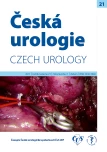Modifications of laparoscopic ureterocystoneostomy
Authors:
Petr Macek 1; Michal Fanta 2; Michael Pešl 1; Michal Mára 2; Vojtěch Fiala 1; Květoslav Novák 1; Tomáš Hanuš 1
Authors‘ workplace:
Urologická klinika VFN a 1. LF UK v Praze
1; Gynekologicko‑porodnická klinika VFN a 1. LF UK v Praze
2
Published in:
Ces Urol 2017; 21(1): 16-19
Category:
Video
Overview
Introduction:
Indications for ureteral reimplantation (ureterocystoneostomy = UCN) include ureteric strictures of various etiology (due to iatrogenic injuries, endometriosis, post radiotherapy etc.), fistulas from ureter into various organs or ureteral trauma. There are a number of modifications, which can be carried out via open or minimally invasive approach (laparoscopic or robot-assisted). Minimally invasive (MI) approach can achieve a good result with decreased perioperative morbidity in many cases.
Aim:
Presentation of modification of minimally invasive UCN on a cohort of 10 patients (11 ureteral units).
Methods:
We perform laparoscopic UCN transperitoneally using 4–5 ports (2x 10mm, 2–3x 5mm) in Trendelenburg position. Initially, the ureter is identified relatively higher in the unaffected area and ideally away from the adhesive process. Following ureteral circumferential dissection a loop is placed around it to minimize traumatization by manipulation and dissection is carried out downwards to the lowermost possible level with sufficient ureteral caliber and here it is divided. Based on ureteral caliber, type of process and length of missing segment to urinary bladder, a type UCN is selected – direct without or with antireflux modification (extravesical or intravesical technique) or psoas hitch or Boari flap in order to bridge a longer defect. Ureter to bladder suturing is done using absorbable 4/0 suture (either continuous or interrupted), with possible “anchoring” sutures using stronger material placed into both poles of the anastomosis. Stenting is performed during intervention and it is left in situ for 4–8 weeks. Bladder catheter is kept for 10–14 days. Length of surgery varies as it depends on the selected UCN modification. Our procedures were between 180 and 1450 minutes (the longest was bilateral UCN with right psoas hitch and left Boari flap including management of underlying deep pelvic endometriosis).
Results:
We operated on 10 patients (8 women and 2 men) between 4/2013 and 12/2016. We performed intervention on 11 ureteral units (i.e. 1 bilateral case). Indications included: 6 women with pelvic deep infiltrating endometriosis (DIE) and ureteric stricture with good renal function (4x left, 1x right, 1 bilateral), 2 women with ureteric strictures following previous hysterectomy, 1 man with distal ureteric stricture following repeated transurethral bladder resection in the area of ureteral orifice (at the time of surgery tumor free for more than 3 years), 1 man with intraoperatively recognized ureteral transection during laparoscopic radical prostatectomy (managed simultaneously). There were 9 extravesical UCN (direct 3x, with psoas hitch 6x), 1 Boari flap (during the bilateral case) and 1 intravesical antireflux Politano- Laedbetter UCN modification. Perioperative course was always uneventful. Intervention due to pelvic DIE were always carried out as one-stage procedure by team of gynecologist and urologist with concurrent complete management of pelvic DIE and ureteral involvement. UCN as management of strictures from previous procedures were all carried out after a 3-month interval. In one patient after bilateral UCN for DIE free intrabdominal fluid was diagnosed (complaining on increased waist circumference, but afebrile, voiding normally, aperitoneal, normal bowel motions), however immediate CT urography and cystography failed to detect any urinary tract leak. Complete resolution occurred after bladder catheter insertion for 2 more weeks. In one patient following bilateral ureteral management (ureteroureteroanastomosis left and UCN with psoas hitch right) positional trauma affecting n. peroneus and deep vein thrombosis occurred, with complete neurologic and vascular resolution following appropriate therapy. One patient following direct extravesical UCN for DIE suffered from symptoms of vesicoureteral reflux after bladder catheter removal, without any infection, and this resolved after 4 weeks of anticholinergic therapy. One patient after UCN for DIE had febrile urinary tract infection following bladder catheter removal 2 weeks after surgery despite antimicrobial prophylaxis, with readmission and antibiotic therapy. All postoperative complications (within 90 days) were Clavien-Dindo grade 2. After stent removal, all patients have a good anatomic and functional result without symptoms of infection or reflux and hydronephrosis.
Conclusions:
Minimally invasive UCN is a procedure with multiple modifications depending on the type of ureteral involvement and length of affected/missing segment. It can be combined as one-stage procedure together with other intervention (such as management of pelvic DIE or if a different operation results in ureteral injury), that however lead to longer duration of surgery. Recognized complications were maximally Clavien- Dindo grade 2. Functional and anatomical results were satisfactory.
KEY WORDS:
Laparoscopy, ureterocystoneostomy, ureter, endometriosis, injury.
Sources
1. Hanuš T, Novák K, et al. Nemoci močovodů. Praha: Galén 2008, 170.
2. Rassweiler JJ, Gozen AS, Erdogru T, et al. Ureteral reimplantation for management of ureteral strictures: a retrospective comparison of laparoscopic and open techniques. Eur Urol, 2007; 51(2): 512–523.
3. Chocholatý M, Schmidt M, Hanek P, Jarolím L. Etiologie, diagnostika a terapie iatrogenních poranění močovodu při otevřených a laparoskopických operacích. Endoskopie 2009; 18(3): 98–102.
4. Schiavina R, Zaramella S, Chessa F, et al. Laparoscopic and robotic ureteral stenosis repair: a multi‑institutional experience with a long-term follow-up. J Robot Surg, 2016; 10(4): 323–330.
5. Hora M, Stránský P, Eret V, et al. Laparoskopicka reimplantace ureteru - video. Cech Urol 2016; 20(2): 97–99.
6. Pešl M, Šafařík L, Pavlík I, et al. Kazuistika nemocné s oboustranným iatrogenním poraněním močovodů. Urol. praxi 2005; 3: 122–123.
Labels
Paediatric urologist Nephrology UrologyArticle was published in
Czech Urology

2017 Issue 1
Most read in this issue
- Modifications of laparoscopic ureterocystoneostomy
- PEYRONIE´S DISEASE
- THE ROLE OF PSYCHOSOMATICS IN UROLOGY
- RARE CYSTADENOCARCIONOMA OF PROSTATE, CLINICAL APPEARANCE, DIAGNOSTIC PROCEDURES AND TREATMENT
